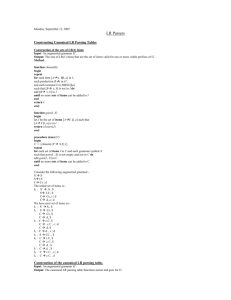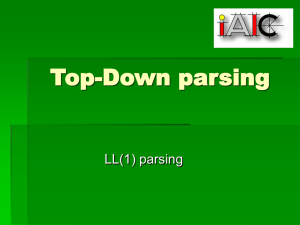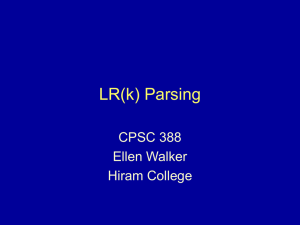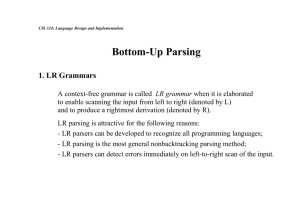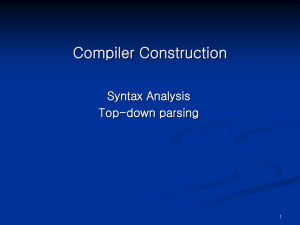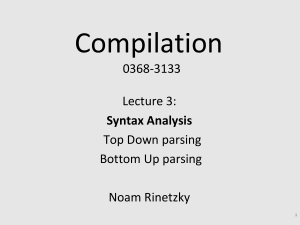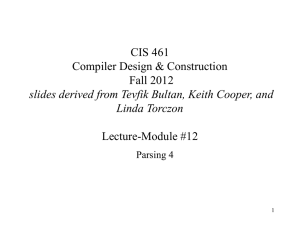LR (k) Grammars - Department of Computer Science
advertisement
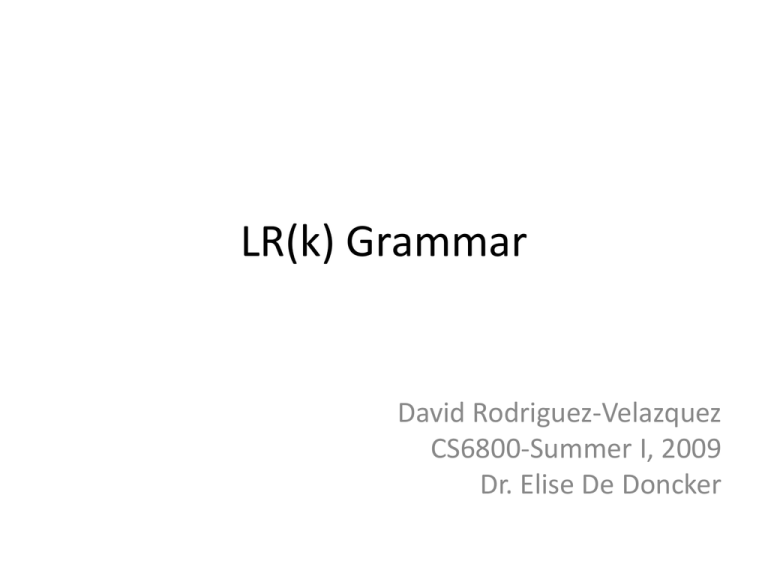
LR(k) Grammar
David Rodriguez-Velazquez
CS6800-Summer I, 2009
Dr. Elise De Doncker
Bottom-Up Parsing
• Start at the leaves and grow toward root
• As input is consumed, encode possibilities in
an internal state
• A powerful parsing technology
• LR grammars
– Construct right-most derivation of program
– Left-recursive grammar, virtually all programming
language are left-recursive
– Easier to express syntax
Bottom-Up Parsing
• Right-most derivation
– Start with the tokens
– End with the start symbol
– Match substring on RHS of production, replace by
LHS
– Shift-reduce parsers
• Parsers for LR grammars
• Automatic parser generators (yacc, bison)
Bottom-Up Parsing
• Example Bottom-Up Parsing
SS+E|E
E num | (S)
(E+2+(3+4))+5
(S+2+(3+4))+5
(S+E+(3+4))+5
(S+(3+4))+5
(S+(E+4))+5
(S+(S+4))+5
(S+(S+E))+5
(S+(S))+5
(S+E)+5
(S)+5
E+5
S+5
S+E
S
(1+2+(3+4))+5
Bottom-Up Parsing
SS + E | E
E num | (S)
• Advantage
– Can postpone the selection of productions until
more of the input is scanned
S
S
S
+
S
1
2
Bottom-Up
Parsing
More time to decide what rules to apply
E
E
E
(
E
+
S
E
1
S
+
)
E
2
Top-Down
Parsing
Terminology LR(k)
•
•
•
•
Left-to-right scan of input
Right-most derivation
k symbol lookahead
[Bottom-up or shift-reduce] parsing or LR
parser
• Perform post-order traversal of parse tree
Shift-Reduce Parsing
• Parsing actions:
– A sequence of shift and reduce operations
• Parser state:
– A stack of terminals and non-terminals (grows to
the right)
• Current derivation step:
= stack + input
Shift-Reduce Parsing
Derivation Step
(Stack + input)
Stack
(terminals &
non-terminals)
Unconsumed
input
(1+2+(3+4))+5 shift
(1+2+(3+4))+5
(E+2+(3+4))+5
(E
+2+(3+4))+5 reduce
(S+2+(3+4))+5
(S
+2+(3+4))+5 reduce
(S+E+(3+4))+5
(S+E
+(3+4))+5 reduce
Shift-Reduce Actions
• Parsing is a sequence of shift and reduces
• Shift: move look-ahead token to stack
Stack
Input
(
1+2+(3+4))+5
(1
+2+(3+4))+5
Action
Shift 1
• Reduce: Replace symbols from top of stack
with non-terminal symbols X corresponding to
the production: X β (e.g., pop β, push X)
Stack
Input
(S+E
+(3+4)+5
(S
+(3+4)+5
Action
Reduce SS+E
Shift-Reduce Parsing
Derivation
Stack
(1+2+(3+4))+5
SS + E | E
E num | (S)
Input stream
Action
(1+2+(3+4))+5
shift
(1+2+(3+4))+5
(
1+2+(3+4))+5
shift
(1+2+(3+4))+5
(1
+2+(3+4))+5
reduce E num
(E+2+(3+4))+5
(E
+2+(3+4))+5
reduce S E
(S+2+(3+4))+5
(S
+2+(3+4))+5
Shift
(S+2+(3+4))+5
(S+
2+(3+4))+5
Shift
(S+2+(3+4))+5
(S+2
+(3+4))+5
reduce E num
(S+E+(3+4))+5
(S+E
+(3+4))+5
reduce S S + E
(S+(3+4))+5
(S
+(3+4))+5
Shift
(S+(3+4))+5
(S+
(3+4))+5
Shift
(S+(3+4))+5
(S+(
3+4))+5
Shift
(S+(3+4))+5
…
(S+(3
+4))+5
reduce E num
Potential Problems
• How do we know which action to take:
whether to shift or reduce, and which
production to apply
• Issues
– Sometimes can reduce but should not
– Sometimes can reduce in different ways
Action Selection Problem
• Given stack β and loock-ahead symbol b, should
parser:
– Shift b onto the stack making it βb?
– Reduce X γ assuming that the stack has the form β
= αγ making it αX ?
• If stack has the form αγ, should apply reduction
Xγ (or shift) depending on stack prefix α ?
– α is different for different possible reductions since γ’s
have different lengths
LR Parsing Engine
• Basic mechanism
– Use a set of parser states
– Use stack with alternating symbols and states
– Use parsing table to:
• Determine what action to apply (shift/reduce)
• Determine next state
– The parser actions can be precisely determined
from the table
LR Parsing Table
Action Table
Goto Table
State
Terminals
Non-Terminals
State number
Next action
and next state
Next State
LR Parsing Table Example
S(L) | id
L S | L,S
NonTerminals
Input Terminal
(
STATE
1
s3
2
Sid
3
S3
)
Id
,
$
s2
Sid
Sid
S
g4
Sid
Sid
s2
g7
4
accept
5
s6
s8
6
S(L)
S(L)
S(L)
S(L)
S(L)
7
LS
LS
LS
LS
LS
8
s3
9
LL,S
s2
LL,S
LL,S
L
g9
LL,S
LL,S
g5
LR (k) Grammars
• LR(k) = Left-to-right scanning, right most
derivation, k lookahead chars
• Main cases
– LR(0) and LR(1)
– Some variations SLR and LALR(1)
• Parsers for LR(0) Grammars:
– Determine the action without any lookahead
– Will help us understand shift-reduce parsing
Building LR(0) Parsing Table
• To build the parsing table
– Define states of the parser
– Build a DFA to describe transitions between states
– Use the DFA to build the parsing table
• Each LR(0) state is a set of LR(0) items
– An LR(0) item: X α.β where X αβ is a production
in the grammar
– The LR(0) items keep track of the progress on all of the
possible upcoming productions
– The item X α.β abstracts the fact that the parser
already matched the string α at the top of the stack
Example LR(0) State
• An LR(0) item is a production from the
language with a separator “.” somewhere in
the RHS of the production
state
Enum.
E(.S)
item
• Sub-string before “.” is already on the stack
(beginnings of possible γ‘s to be reduced)
• Sub-string after “.”: what we might see next
Start State and Closure
• Start state
– Augment grammar with production: S’ S$
– Start state of DFA has empty stack: S’ .S$
• Closure of a parser state:
– Start with Closure(S) =S
– Then for each item in S:
• X α.γβ
• Add items for all the productions Y γ to the closure
of S: Y . γ
Closure Example
S(L) | id
L S | L,S
DFA start state
S’ . S $
closure
S’ . S $
S.(L)
S . id
• Set of possible production to be reduced next
• Added items have the “.” located at the
beginning no symbols for these items on the
stack yet
The Goto Operation
• Goto operation : describes transitions
between parser states, which are sets of items
• Algorithm: for state S and a symbol Y
– If the item [X α . Y β] is in I(state), then
– Goto(I,Y) = Closure([X α . Y β] )
S’ . S $
S.(L)
S . id
Goto(S,’(‘)
Closure( { S ( . L ) } )
Shift: Terminal Symbols
Grammar
S(L) | id
L S | L,S
S’ . S $
S.(L)
S . id
(
id
S (.L)
L.S
L.L,S
S.(L)
S . id
id
(
S id .
In new state, include all items that have appropriate input symbol just
after dot, advance dot in those items and take closure
Goto: Non-terminal Symbols
Grammar
S(L) | id
L S | L,S
S’ . S $
S.(L)
S . id
(
id
L
S (.L)
L.S
L.L,S
S.(L)
S . id
id
S(L.)
LL.,S
S
L S.
(
S id .
Same algorithm for transitions on non-terminals
Applying Reduce Actions
Grammar
S(L) | id
L S | L,S
S’ . S $
S.(L)
S . id
(
id
S id .
L
S (.L)
L.S
L.L,S
S.(L)
S . id
id
S(L.)
LL.,S
S
L S.
(
States causing reduction
(dot has reached the end)
Pop RHS off stack, replace with LHS X (X β ), then
rerun DFA
Full DFA
Grammar
S(L) | id
L S | L,S
id
S id . 2
id
S’ . S $
S.(L)
S . id 1
S
(
id
S (.L)
L.S
L.L,S
S.(L)
S . id 3
S
L S. 7
S’ S . $ 4
$
Final state
(
L L,. S
S.(L)
S . id 8
S
,
L
SL,S.
S(L.)
LL.,S
5
)
(
S (L).
6
9
LR Parsing Table Example
S(L) | id
L S | L,S
NonTerminals
Input Terminal
(
STATE
1
s3
2
Sid
3
S3
)
Id
,
$
s2
Sid
Sid
S
g4
Sid
Sid
s2
g7
4
accept
5
s6
s8
6
S(L)
S(L)
S(L)
S(L)
S(L)
7
LS
LS
LS
LS
LS
8
s3
9
LL,S
s2
LL,S
LL,S
L
g9
LL,S
LL,S
g5
Building the Parsing Table
• States in the table = states in the DFA
• For transitions S S’ on terminal C:
– Table [S,C] = Shift(S’) where S’ = next state
• For transitions S S’ on non-terminal N
– Table [S,N] = Goto(S’)
• If S is a reduction state X β then:
– Table [S, *] = Reduce(x β)
Parsing Algorithm
• Algorithm: look at entry for current state s and
input terminal a
– If Table[s, a] = shift then shift:
• Push(t), let ‘a’ be the next input symbol
– If Table[s, a] = Xα then reduce:
• Pop(| α |) , t = top(), push(GOTO[t,X]), output X α
Reductions
• On reducing X β with stack α β
– Pop β off stack, revealing prefix α and state
– Take single step in DFA from top state
– Push X onto stack with new DFA state
• Example:
Derivation
Stack
Input
Action
((a),b
1(3(3
a),b)
shift, goto 2
((a),b
1(3(3 a 2
),b)
reduce S id
((S),b
a(3(3 S 7
),b)
reduce L S
LR(0) Summary
• LR(0) parsing recipe:
– Start with LR(0) grammar
– Compute LR(0) states and build DFA
• Use the closure operation to compute states
• Use the goto operation to compute transitions
– Build the LR(0) parsing table from the DFA
• This can be done automatically
– Parser Generator Yacc
Question: Full DFA for this grammar
Grammar
S(L) | id
L S | L,S
S id . 2
id
id
(
id
S’ . S $
S.(L)
S . id 1
S
(
S (.L)
L.S
L.L,S
S.(L)
S . id 3
S
L S. 7
S’ S . $ 4
$
Final state
L
L L,.S
S.(L)
S . id 8
S
,
SL,S.
S(L.)
LL.,S
5
)
(
S (L).
6
9
References
• Aho A.V., Ullman J. D., Lam M., Sethi R.,
“Compilers Principles, Techniques & Tools”,
Second Edition,Addison Wesley
• Sudkamp A. T., An Introduction the Theory of
Computer Science L&M, third edition, Addison
Wesley
Question: Parsing ((a),b)
S(L) | id
L S | L,S
Derivation
Stack
Input stream
Action
((a),b)
1
((a),b)$
shift, goto 3
((a),b)
1(3
(a),b)$
shift, goto 3
((a),b)
1(3(3
a),b)$
shift, goto 2
((a),b)
1(3(3a2
),b)$
reduce S id
((S),b)
1(3(3S7
),b)$
reduce L S
((L),b)
1(3(3L5
),b)$
shift, goto 6
((L),b)
1(3(3L5)6
,b)$
reduce S (L)
(S,b)
1(3S7
,b)$
reduce L S
(L,b)
1(3L5
,b)$
shift, goto 8
(L,b)
1(3L5,8
b)$
shift, goto 9
(L,b)
1(3L5,8b2
)$
reduce S id
(L,S)
1(3L5,8S9
)$
reduce L L,S
(L)
1(3L5
)$
shift, goto 6
(L)
1(3L5)6
$
reduce S (L)
S
1S4
$
Done
